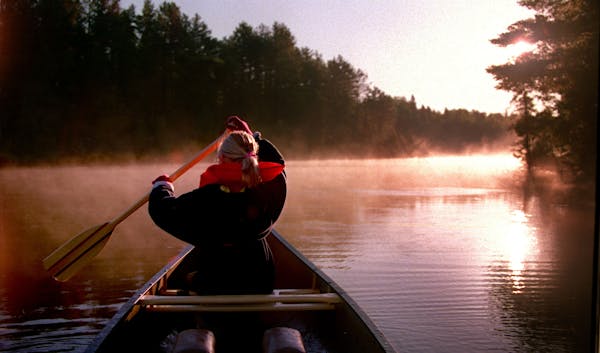At your local bait shop, night crawlers — the iconic, catch-everything-with-fins live bait — sell for as little as $3 a dozen. The slippery earthworms typically come in small Styrofoam containers and are refrigerated to preserve their freshness.
"Night crawlers are our most popular live bait in the summer — them and leeches," said an attendant at Christopherson Bait Shop in Alexandria, Minn., echoing the sentiments of other shops in the state. "They're popular because they work."
The summer fishing season is heating up, and night crawlers and other earthworms are the go-to baits for countless Minnesota anglers — just like they have been for decades. But these seemingly innocent worms, often plucked by anglers from lawns after a soaking rain, have a little-known history of destruction: They're nonnative, invasive species from Europe that have invaded Minnesota's hardwood timberland and eat up vegetation that is vital to forest health, according to researchers. And anglers are at least partly responsible for their distribution. State officials, meanwhile, are calling on anglers and others to help stop — or at least contain — their spread.
"Earthworms can reduce the growth rates of trees, they can cause harm to native plants species and animal species, and can result in a decline of their habitat, among other significant problems that can affect soil chemistry and water quality," said Lee Frelich, director of the University of Minnesota's Center for Forest Ecology.
There's no talk of restricting or prohibiting earthworms for fishing in Minnesota. Still, the state Department of Natural Resources (DNR) has tried to spotlight the destructiveness of worms. Laura Van Riper, DNR terrestrial invasive species program coordinator, said the agency is trying to raise public awareness, but she admitted the message might get drowned out by talk of other invasive species.
"We're definitely not where we want to be," said Riper, adding the DNR has highlighted the earthworm problem at State Fair exhibits, on the agency website, and in its fishing regulations handbook. "The fact is earthworms are here and we need to stop their spread. The bottom line for anglers with extra earthworms is this: don't throw them way on the ground or in the water. Throw them in the garbage."
Piggybacking with settlers
Frelich, who said there are no native earthworms in Minnesota, has been studying the so-called earthworm invasion for nearly 20 years. He said there is no evidence that "earthworms ever inhabited Minnesota before European settlement" in the 1800s and 1900s. For the last 11,000 years since the glaciers receded, Minnesota diverse landscape ecosystems evolved without them.
"The first earthworms likely arrived with soil and plants brought from Europe," Frelich said. About 15 earthworm species have been identified in Minnesota. North America-bound ships, he said, used rocks and soil as ballast and dumped their loads ashore. European settlers imported plants that had earthworms or their cocoons (egg cases) in their soils. More recently, plants and sod from nursery operations are thought to have contributed to their spread in the state.
Earthworm-free hardwood forests have a naturally loose soil with a thick layer of "duff" — the spongy organic layer created primarily by decomposed leaves. Invading earthworms, Frelich said, eat the duff and are capable of eliminating it completely. Large forest trees survive, but young seedlings die, as do many native wildflowers and ferns. The lack of leaf litter in general makes trees and plants more sensitive to drought. Earthworms can eliminate the entire vegetative understory of a forest.
"They create an ecological cascade," said Frelich of the problems caused by earthworms, including lost wildlife habitat. "In heavily infested areas, soil erosion and leaching nutrients may reduce productivity of forests and ultimately degrade water quality and fish habitat."
Frelich said the flood of worms has spread "basically a 100 percent" in the agricultural woodlots of southern and western Minnesota and throughout a sizable portion north-central and northern Minnesota. Voyageurs National Park has banned live bait on interior lakes, hoping to prevent the spread of invasive species, including earthworms. Roughly 50 percent of the Boundary Waters Canoe Area Wilderness, where Frelich is conducting research, is infested — likely by anglers.
"What we've found is that infestation is related to human use," Frelich said, noting earthworms on their own move only 20 to 30 feet per year. "Infestations are related to camp sites and portage trails where earthworms are likely being dumped."
Such habitat changes can affect forest wildlife. Frelich said ground-nesting birds like ovenbirds and others are less abundant in areas with earthworms. More research is needed, he said, to understand the impact to wildlife.
However, a new DNR study showing a significant decrease in natural bear food primarily in the Chippewa National Forest could be linked to the lowly earthworm. "We've found a 70 percent decline in fruit biomass from the research we conducted in the same areas in the 1980s," said Dave Garshelis, DNR bear project leader. "We've been trying to increase the bear population for over a decade but it hasn't comeback as quickly as we thought it would. One possible reason is a lack of food."
Although Garshelis can't prove earthworms are responsible for the reduction in natural bear food, he said "it's my leading hypothesis right now."
"If it is earthworms, it's a terrible story for bears," he said, "because we likely can't do anything about it."
Tori J. McCormick is a freelance writer from Prior Lake. Reach him at torimccormick33@gmail.com.
Buffalo Bills owner Terry Pegula explores selling non-controlling, minority stake in franchise

Reusse: Wolves need stopper for Booker? NAW, it's not a problem.

